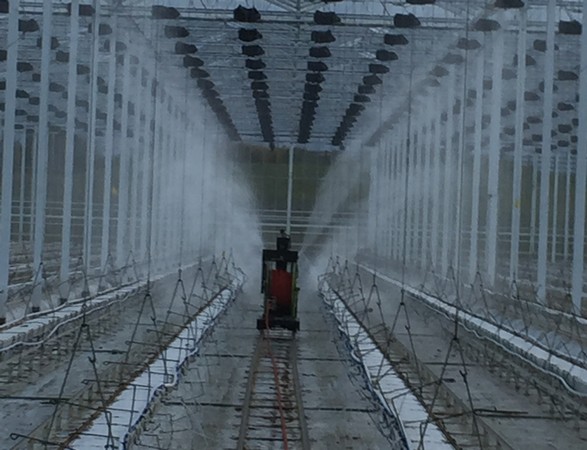Disinfecting with ToBRFV: "Do not hold back, keep things thoroughly drenched"
 No grower wants contamination, but in spite of the best precautions it is still possible that the Tomato Brown Rugose Fruit Virus (ToBRFV) strikes. By now, there is experience with good disinfection and 'cleaning' the greenhouse again. The motto is: clearing everything out, cleaning the entire greenhouse and then keeping everything completely wet for a long time so contact agents can do their work properly.
No grower wants contamination, but in spite of the best precautions it is still possible that the Tomato Brown Rugose Fruit Virus (ToBRFV) strikes. By now, there is experience with good disinfection and 'cleaning' the greenhouse again. The motto is: clearing everything out, cleaning the entire greenhouse and then keeping everything completely wet for a long time so contact agents can do their work properly.
Experience gained
The latter protocol was used by Gert-Jan van Hattem, Sproeibedrijf van Hattem, at growers in the Netherlands, Germany and the United Kingdom. In that last country, a greenhouse of Thanet Earth was officially declared 'clean' after a team of Van Hattem thoroughly cleaned the greenhouse with special, extra powerful pumps and spraying technique. "I would like to say that you have to drown ToBRFV. Expensive, a lot of work, but the only effective way."
With the increasing virus pressure in greenhouse horticulture, not just for tomatoes with ToBRFV, but in the last years also in cucumbers with CGMMV for example, he saw the demand for the extreme way of cleaning increase. "I am not the inventor of this technique, but have started to apply the technique on a large scale, although I do not pretend to be the specialist in the field of virus disinfection. We have knowledge of cleaning properly and thoroughly."
Get everything
That was exactly what Gert-Jan and his team did recently in the United Kingdom. "First, the greenhouse was cleaned out, and I demand the greenhouse to be completely empty and I do not accept lingering plant residue or things like that. Some growers first fog themselves, using formalin."
When emptying the greenhouse has been done properly, Gert's team takes the spraying machine into the greenhouse to spray a special fluid with 1.5% chlorine solution with quantities of 2.5 liters per square meter, ten hectares per day at Thanet Earth.
It is really of the utmost importance to get everything in the greenhouse, in the experience of Gert-Jan. "The nozzles on our equipment spray the bottom side of the gutters, on the gutters, and higher, and the upper two nozzles spray the inside of the greenhouse.
Thoroughly wet
At that moment, to use the words of Gert-Jan, everything is already thoroughly wet. Then follows a round of hydrogen-peroxide-based products. "Also here, we use large quantities of fluid. I am of the opinion that you must not hold back with these kind of viruses. Only when you immerse the virus for a longer period time, the contact agents do their work properly."
Finally, there are growers who choose for a final fogging with another hydrogen peroxide-based product.
Grower chooses agents
Gert-Jan still sometimes sees that when disinfecting their greenhouse, growers believe online spraying chlorine is sufficient. "I do not recommend this, because I do not believe it is sufficient to really clean the greenhouse. I believe it is better to use hydrogen peroxide-based products, although it is the grower who always chooses the agents or the combination of agents we are going to spray. The only thing we pay attention to, also internationally, is whether the agents are allowed. And internationally, we always ask the grower to purchase the agents themselves."
Better good than quick
After the thorough disinfection treatment, the greenhouse must dry. Chlorine breaks down automatically when in contact with sunlight. "My advice is to keep the greenhouse wet for at least three or four days. Although growers want to reduce the time the greenhouse is empty to a minimum, I still advise them to be patient and thorough when disinfecting. You really do not want to have problems with the virus a couple of months later because the contact period with disinfecting agents was not long enough."
After the greenhouse has dried, the substrate mats can be installed again. Sometimes even the day after, in the experience of Gert-Jan.
125 hectares in one week
Since early 2019, when ToBRFV really started wreaking havoc, there were weeks when the company sprayed 125 hectares in one week, in 5 rounds of disinfecting 25 hectares. "It is so busy right now that we have to contract 1/3 of our regular chalking and coating jobs to colleagues because we are overwhelmed with disinfection work. Machines we have plenty, but sometimes we are short on people."
Powerful fogging
With a view to developments in disinfection, Sproeibedrijf Van Hattem is working to extend the machine park. "We are not fogging ourselves yet, because I am of the opinion you really have to be able to get everything to make it work properly. That is why we are building a machine which is able to just to that, so we can also provide fogging services ourselves."
For more information:
Sproeibedrijf Van Hattem
www.van-hattem.nl
This email address is being protected from spambots. You need JavaScript enabled to view it.
Publication date: Thu 16 Jul 2020
© HortiDaily.com